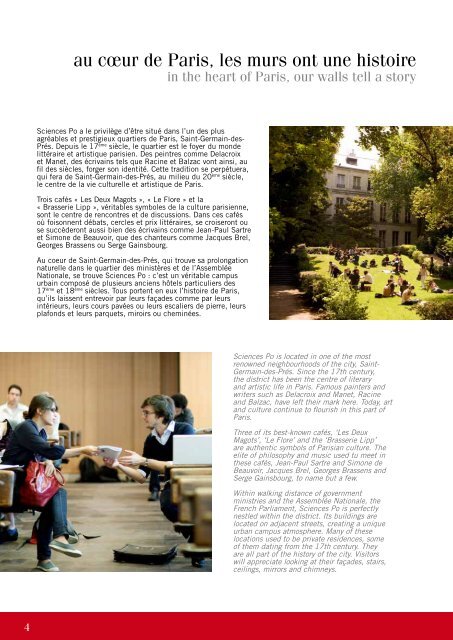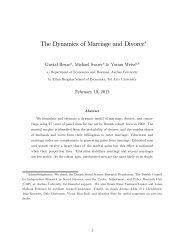Sciences Po et vous
Sciences Po et vous
Sciences Po et vous
Create successful ePaper yourself
Turn your PDF publications into a flip-book with our unique Google optimized e-Paper software.
4<br />
au cœur de Paris, les murs ont une histoire<br />
in the heart of Paris, our walls tell a story<br />
<strong>Sciences</strong> <strong>Po</strong> a le privilège d’être situé dans l’un des plus<br />
agréables <strong>et</strong> prestigieux quartiers de Paris, Saint-Germain-des-<br />
Prés. Depuis le 17 ème siècle, le quartier est le foyer du monde<br />
littéraire <strong>et</strong> artistique parisien. Des peintres comme Delacroix<br />
<strong>et</strong> Man<strong>et</strong>, des écrivains tels que Racine <strong>et</strong> Balzac vont ainsi, au<br />
fil des siècles, forger son identité. C<strong>et</strong>te tradition se perpétuera,<br />
qui fera de Saint-Germain-des-Prés, au milieu du 20 ème siècle,<br />
le centre de la vie culturelle <strong>et</strong> artistique de Paris.<br />
Trois cafés « Les Deux Magots », « Le Flore » <strong>et</strong> la<br />
« Brasserie Lipp », véritables symboles de la culture parisienne,<br />
sont le centre de rencontres <strong>et</strong> de discussions. Dans ces cafés<br />
où foisonnent débats, cercles <strong>et</strong> prix littéraires, se croiseront ou<br />
se succèderont aussi bien des écrivains comme Jean-Paul Sartre<br />
<strong>et</strong> Simone de Beauvoir, que des chanteurs comme Jacques Brel,<br />
Georges Brassens ou Serge Gainsbourg.<br />
Au coeur de Saint-Germain-des-Prés, qui trouve sa prolongation<br />
naturelle dans le quartier des ministères <strong>et</strong> de l’Assemblée<br />
Nationale, se trouve <strong>Sciences</strong> <strong>Po</strong> : c’est un véritable campus<br />
urbain composé de plusieurs anciens hôtels particuliers des<br />
17 ème <strong>et</strong> 18 ème siècles. Tous portent en eux l’histoire de Paris,<br />
qu’ils laissent entrevoir par leurs façades comme par leurs<br />
intérieurs, leurs cours pavées ou leurs escaliers de pierre, leurs<br />
plafonds <strong>et</strong> leurs parqu<strong>et</strong>s, miroirs ou cheminées.<br />
<strong>Sciences</strong> <strong>Po</strong> is located in one of the most<br />
renowned neighbourhoods of the city, Saint-<br />
Germain-des-Prés. Since the 17th century,<br />
the district has been the centre of literary<br />
and artistic life in Paris. Famous painters and<br />
writers such as Delacroix and Man<strong>et</strong>, Racine<br />
and Balzac, have left their mark here. Today, art<br />
and culture continue to flourish in this part of<br />
Paris.<br />
Three of its best-known cafés, ‘Les Deux<br />
Magots’, ‘Le Flore’ and the ‘Brasserie Lipp’<br />
are authentic symbols of Parisian culture. The<br />
elite of philosophy and music used tu me<strong>et</strong> in<br />
these cafés, Jean-Paul Sartre and Simone de<br />
Beauvoir, Jacques Brel, Georges Brassens and<br />
Serge Gainsbourg, to name but a few.<br />
Within walking distance of government<br />
ministries and the Assemblée Nationale, the<br />
French Parliament, <strong>Sciences</strong> <strong>Po</strong> is perfectly<br />
nestled within the district. Its buildings are<br />
located on adjacent stre<strong>et</strong>s, creating a unique<br />
urban campus atmosphere. Many of these<br />
locations used to be private residences, some<br />
of them dating from the 17th century. They<br />
are all part of the history of the city. Visitors<br />
will appreciate looking at their façades, stairs,<br />
ceilings, mirrors and chimneys.

















